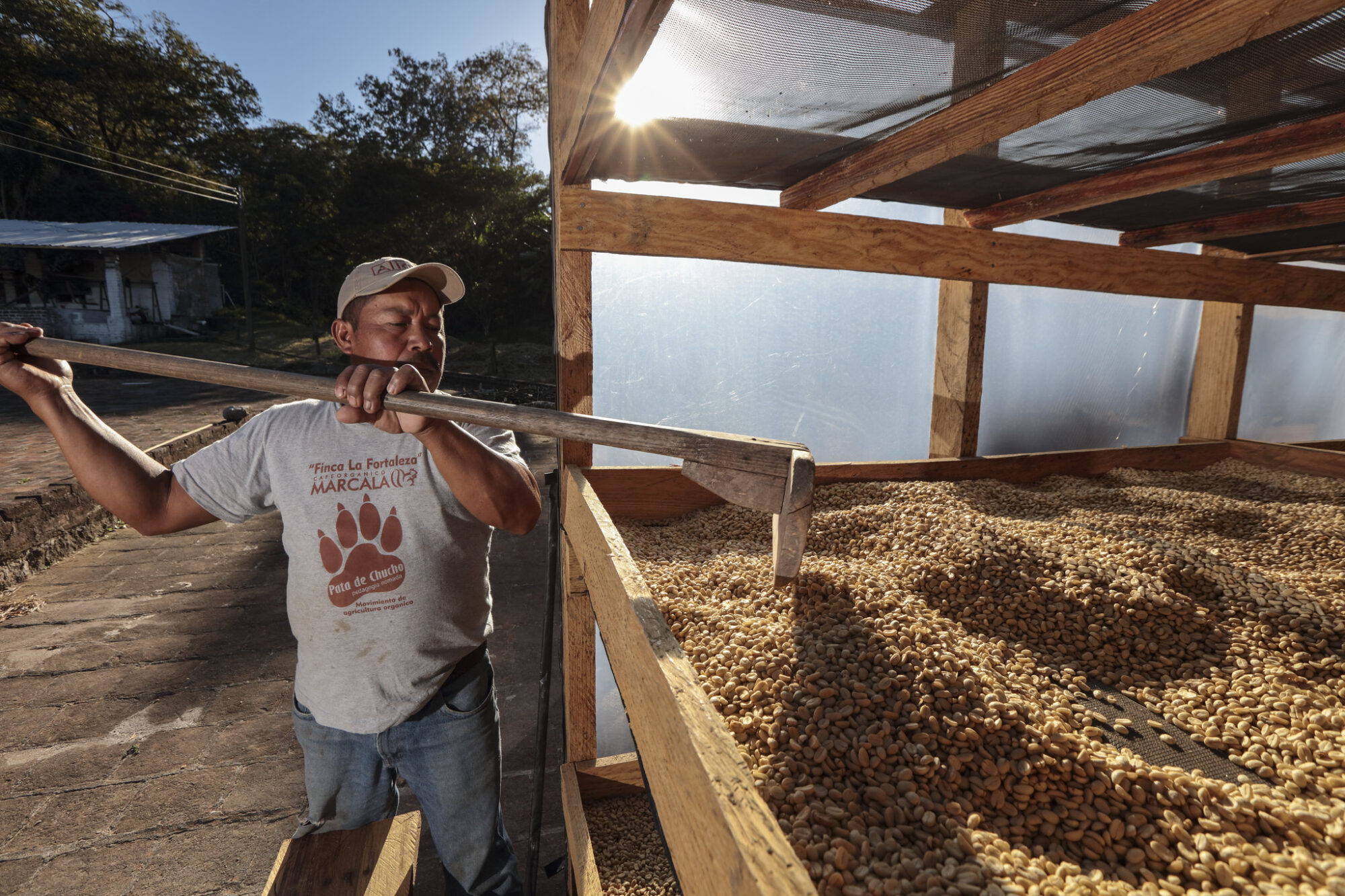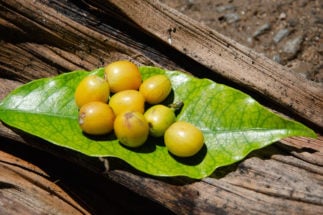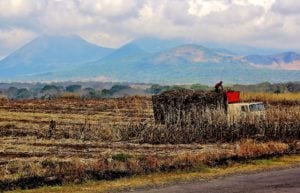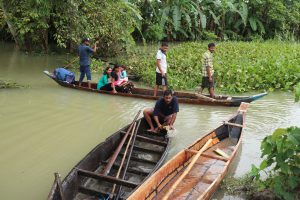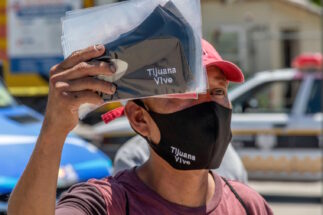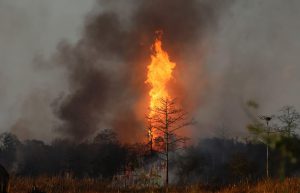In October 2018, a caravan of over 7,000 Central American migrants set off on a perilous journey by foot to try and cross Mexico and eventually reach the US.
Around three-quarters of people who attempt to migrate in large groups from Mexico to the US are from Honduras, according to a UN survey of people arriving at Tijuana in autumn 2018. Of those surveyed, 28% had worked in agriculture.
Honduras is the world’s sixth-largest producer of coffee, but in recent years poor weather and a deteriorating economic climate have driven scores of farmers to abandon their farms and flee north. In 2019 alone, land use for coffee production in Honduras decreased by 5%, or 19,000 hectares.
Coffee farms in Central America are particularly vulnerable to climate change, as small variations in temperature and rainfall can have a significant impact on yields and profitability.
“Arabica [coffee] requires cool temperatures of 18-21C and very specific amounts of rainfall, conditions that are generally found in the tropical highlands. As temperatures rise, areas where coffee can grow become more limited,” according to Raina Lang from Conservation International.
By some estimates, changing temperatures and rainfall could lead to a 38%-89% reduction in the land available for coffee farming in Central America by 2050. The potential loss for Honduras could be up to 50%, says Lang.
100,000
acres of coffee plantations were lost in Colombia between 2018 and 2019
The situation is also dire in Colombia, where unpredictable weather has driven many of the country’s estimated 500,000 smallholder farmers out of business. Between 2018 and 2019, Colombia lost close to 100,000 acres of coffee plantations, equivalent to over 4% of the country’s total, according to the National Federation of Coffee Growers (Fedecafé).
Brazilian coffee beans flood the market
In addition to climate change, smallholder coffee farmers across Latin America face a tough economic situation resulting from oversupply and low international prices.
In 2018, Brazil, which accounts for around one third of global coffee output and exports, produced a record 62 million bags. This significantly increased global supply and sent international benchmarks prices to their lowest levels in 13 years. Last year its share of global coffee exports rose from 29% to 32%. It is expected to go up again in 2020.
Brazil’s 2018 bumper harvest also coincided with a weak currency, which further undermined the competitiveness of other regions.
Dramatically lower prices meant that Central American farmers were no longer able to cover their costs, estimated to be 30% higher than those of Brazil because their operations are smaller and they focus on premium varieties.
China’s growth market
In China, coffee consumption has been increasing at an average annual rate of 16% in the last decade, taking the value of its market to an estimated US$43 billion as of 2020.
Luckin Coffee, which in three years has become China’s largest coffee chain with 4,500 branches, surpassing Starbucks’ 4,300, best exemplifies this growth.
Most of Luckin Coffee’s locations are akin to “cloud kitchens” – open spaces with no seating that focus on deliveries and pickups, enabled by its strong technology platform. The company listed on the Nasdaq stock exchange in May 2019, fetching a valuation close to US$3 billion.
Seattle-based Starbucks has had its own remarkable Chinese growth story, and was credited by many for acquainting local palates with coffee and laying the groundwork for the subsequent boom. Since opening its first Beijing store in 1999, Starbucks has made China the focus of its strategy for global growth. In 2017 the company launched the Reserve Roastery Shanghai, then the world’s largest Starbucks.
In spite of remarkable growth, China’s is still only a fraction of the size of more mature markets.
According to the US Department of Agriculture, China’s yearly coffee consumption is 3.3 million bags, equivalent to only 12% of the 27.3 million bags consumed in the US. Europe is the world’s largest market, consuming 46.2 million bags. Brazil is third with 23.5 million.
3.3 million
the number of bags of coffee consumed by China every year
Although China is currently only the world’s ninth-largest importer of coffee, the country is seen as an increasingly important destination for producers such as Brazil and Colombia.
Brazil’s coffee exports to China more than doubled between 2015 and 2019, according to Eduardo Heron Dos Santos of the National Coffee Exporters Council (Cecafe), in an interview for Xinhua. Brazil exported 177,000 bags to China in 2019.
Dos Santos attributes this growth to the increasing popularity of coffee amongst China’s young urbanites, and the relentless expansion of coffee chains such as Luckin Coffee and Starbucks.
Colombia, meanwhile, is targeting an increase in coffee exports to China from 40,000 bags to 300,000 bags over the next four years.
Yet for Honduras, Guatemala and Nicaragua, hopes of becoming major exporters to China remain distant as long as these countries maintain diplomatic relations with Taiwan, which makes trade significantly more difficult and costly.
Giving small coffee farmers impacted by climate change a chance
Both the non-profit and private sector players have been trying to help small coffee farmers cope with the dual impacts of climate change and a challenging economic outlook.
Starbucks, which purchases about 3% of global coffee production, and close to 40% of specialty arabica varieties farmed in Central America, has made direct payments to support over 8,000 farmers in Mexico, El Salvador, Nicaragua and Guatemala.
These payments are meant to mitigate the impact of low international prices and ensure that farmers can continue to operate. In addition to direct payments, Starbucks also runs training and knowledge-sharing programmes to help farmers adapt to the changing climate.
Former Starbucks CEO Howard Schultz was quoted by Time magazine as saying: “Make no mistake, climate change is going to play a bigger role in affecting the quality and integrity of coffee.”
Keurig Green Mountain, another major coffee purchaser, part of JAB Holding Company (which also owns Peet’s Coffee, Caribou Coffee and Krispy Kreme), runs another programme to train farmers in El Salvador, Honduras and Nicaragua on coping with water scarcity.
Small farmers also stand a better chance when they work together, according to Catherine Tucker from the University of Florida, who has spent over two decades researching coffee farmers in Honduras. “Farmers that are part of a larger cooperative can adapt better,” she says.
One such cooperative is Café Orgánico Marcala (COMSA), a group of 1,200 organic coffee producers in Honduras. By training farmers to produce high quality coffee, and marketing its sustainability credentials, COMSA is able to secure higher prices and improve the livelihood of its members.
Consumers also have a role to play. “If we want to have that quality coffee, we need to get people to pay for it. Because if we don’t, that coffee is going to disappear,” says Tucker.
“Being conscious about where our coffee is coming from […] Thinking about the producers who make our coffee, and [being] willing to pay that extra bit to help them cover their costs, that will help make a difference.”
